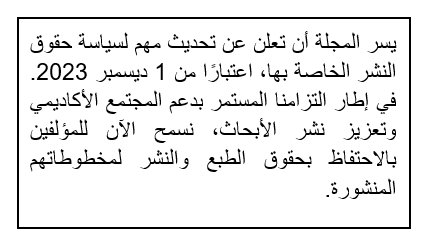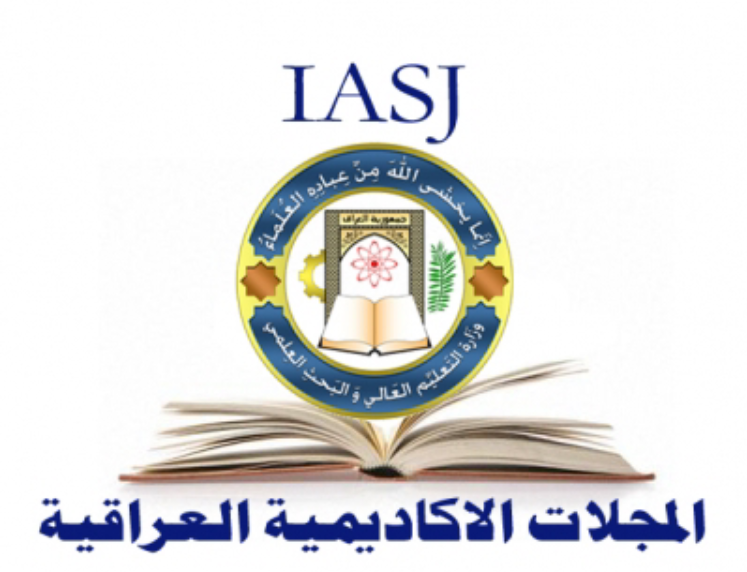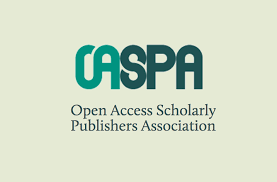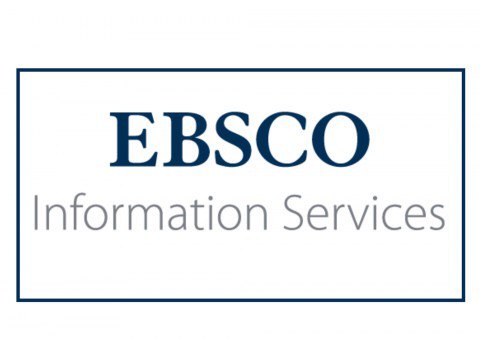مسار العلاقات الصينية الهندية بعد عام 2013: الفرص والتحديات
DOI:
https://doi.org/10.30907/jcopolicy.vi64.571الكلمات المفتاحية:
الصين، الهند، الفرص، التحديات، الأفاق المستقبليةالملخص
تعد الصين والهند عملاقان صاعدان، وكلاهما من أكثر دول العالم سكانًا وأسرعهم نموًا اقتصاديًا. وقد ساهم النمو بعيد المدى في كل من الصين والهند في تعزيز أهمية علاقتهما الثنائية. وتتسم العلاقات بين الصين والهند بالتعقيد، إذ مرت العلاقات بينهما بتغيرات كبيرة خلال العقود السبعة الماضية تراوحت بين الصداقة والعداء. وانطلقت الدراسة من فرضية مفادها أن طبيعة العلاقات الصينية الهندية ومسارها بعد عام 2013 تأثرت بجملة من العوامل والمتغيرات مَثلت بعضها فرصاً وأخرى تحديات وعوائق. فقد ساهمت عدد من الفرص في إعادة صياغة العلاقات الثنائية من حيث المكاسب المتبادلة وتعزيز التعاون والتقارب في المجالات المختلفة وخاصةً الاقتصادية، إلا أنه بالرغم من ذلك لاتزال توجد مجموعة من التحديات والقيود التي لم يتم التوصل لحلول جذرية بشأنها تحول دون تطور العلاقات الثنائية إلى المستوى المنشود. كما توصلت الدراسة إلى نتيجة مفادها أنه يقع على عاتق البلدين العمل معاً على تقليص خلافتهما والتخلص من عبء الماضي ودفع التقارب والتعاون الثنائي إلى أعلى مستوياته.
المراجع
هوامش توضيحية:
* اتفاقية بانشيل: هي مجموعة من المبادئ التي تحكم العلاقات بين الدول، وتتمثل في (الاحترام المتبادل لوحدة أراضي وسيادة كل طرف، عدم الاعتداء المتبادل، عدم التدخل المتبادل في الشؤون الداخلية للآخر، المساواة والمنفعة المتبادلة، والتعايش السلمي).
* الإصلاحات الاقتصادية: أطلق الحزب الشيوعي الصيني بزعامة دنج شياو بينج في عام 1978سلسلة من الإصلاحات الاقتصادية تقوم على الإصلاح الداخلي والانفتاح على العالم الخارجي.
* التوازن الناعم: هو مجموعة من الاستراتيجيات غير العسكرية التي تسعى إلى تقويض القوة النسبية للدول المهددة عبر التنسيق الثنائي والمتعدد الأطراف.
قائمة المصادر:
الأحمر، فادي عبد الغني. 2020. "المعضلة الأمنية وأثرها في التنافس الصيني-الهندي." المجلة الأكاديمية للبحوث القانونية والسياسية 4، عدد.1(مارس): 126-143.
بارواه، براناميتا .2014. "انقلاب التحالفات: إعادة تشكيل العلاقات الإقليمية والدولية في شرق أسيا." 1 سبتمبر، 2014. https://futureuae.com/ar-AE/Mainpage/Item/
كمال، محمد مصطفي. 2020."كورونا والفيل والتنين". المصري اليوم. 8 يونيو، 2020.https://www.almasryalyoum.com/news/details/1985832
لبنى، جصاص. 2017. "أبعاد التنافس الصيني الهندي للهيمنة الإقليمية في جنوب أسيا." أطروحة دكتوراة، جامعة الحاج لخضر باتنة/ كلية الحقوق والعلوم السياسية.
List of References:
Acharya, Amitra. 2017. East of India, South of China: Sino-Indian Encounters in Southeast Asia. New Delhi: Oxford University press.
Arif, Sheikh Mohd. 2013. “A History of Sino-Indian Relations: From Conflict to Cooperation.” Academic Research Journals 1, no.4: 110-18.
Banerjee, Atreyee, and Madhurima Chowdhury. 2016. “India-China Relations a Sino-Indian Perspective.” In India and China Relations: Historical, Cultural and Security Issues, edited by G. Jayachandra Reddy, 101-118. Sri Venkateswara University: UGC Center for Southeast Asian Pacific Studies.
Choudhry, Misbah Tanveer, Enrico Marelli, and Marcello Signorelli.2020. “China, and India’s Global Integration in the Process of Economic Development.” In China-India Relations: Geo-political Competition, Economic Cooperation, Cultural Exchange and Business Ties, edited by Young Chan Kim, 59-80. Switzerland: Springer.
Cunningham, Philip. 2020. “A Diplomatic Precedent for Resolving Sion-India Tensions.” July 2, 2020.
Gilboy, George J., and Eric Higinbotham. 2014. “Double Trouble.: A Realist View of Chinese and Indian power.” The Washington Quarterly 36, no.3: 125-42. doi.org/10.1080/0163660X.2013.825554
Government of India. 2015. “Joint Statement between the India and China during Prime Minister's visit to China.” May 16, 2015. https://www.business-standard.com/article/government-press-release/joint-statement-between-the-india-and-china-during-prime-minister-s-115051500305_1.html
Hellstrom, Jerker, and Kaan Korkmaz. 2011. “Managing Mutual Mistrust: Understanding Chinese Perspectives on Sino – Indian Relations.” FOI. Report, September 2011. https://www.foi.se/rest-api/report/FOI-R--3271--SE.
Li, Zhang. 2010. “China – India Relations: Strategic Engagement and Challenges.” Centre For Asian Studies. Report no.34. September 2010. https://www.ifri.org/sites/default/files/atoms/files/asievisions34zhangli.pdf.
Maurya, D. Kumar. 2017. “Recent Development of Sino-Indian Relations: Economic Perspective.” International Journal of English Language 5, no.8: 1215-20.
Ministry of Commerce & Industry.2021. “Trade Deficit Between India and China.” PIB Delhi. February 3, 2021.
https://pib.gov.in/PressReleasePage.aspx?PRID=1694820.
Ondris, Juraj. 2016. “China-India Relations in The New Millennium.” Economic Review 45, no.2: 170-80.
Panda, Jagannath P., and AtmajaGohain Baruah. 2019. “Foreseeing India-China Relations: The Compromised Context of Rapprochement.” East-West Centre. Report no.138. July 2019.
http://dcac.du.ac.in/documents/E-Resource/2020/Metrial/403Cihnnita Baruah2.pdf.
Pant, Harsh V., and Kartik Bommakanti. 2019. “India’s National Security: Challenges and Dilemmas.” International Affairs 95, no.4:835–57.
---.2014. “The Growing Complexity of Sino-Indian Ties, Strategic Studies Institute.” US Army War College. June 2014.
https://www.jstor.org/stable/resrep11423?seq=1#metadata_info_tab_contents.
Passin, Herbert.1961. “Sino-Indian Cultural Relations.” The China Quarterly, no.7 (September):85-100.
Raghavan, Srinath. 2019. “The Security Dilemma and India-China Relations.” Asian Security 15, no.1: 60-72.
Rajagopalan,Rajeswari Pillai. 2020. “ How Is COVID-19 Reshaping China-India Relations?” The Diplomat. April 2, 2020. https://thediplomat.com/2020/04/how-is-covid-19-reshaping-china-india-relations/.
Ratha, Keshab Chandra, and Sushanta Kumar Mahaptra. 2015. “Recasting Sino-Indian Relations: Towards A Closer Development Partnership.” Strategic Analysis 39, no.6: 696- 709. doi:10.1080/09700161.2015.1090683.
Sahu, Dipika. 2018. “Impact of Bilateral Trade Between India and China on Economic Growth of India.” International Journal of Management, IT and Engineering 8, no.2 (February): 183-96.
Saran, Shyam. 2017. “Changing Dynamics in India-China Relations.” China Report 53, no.2: 72-95.
Sheen, Seong Ho. 2019. “China's Military Power Trajectory.” East Asia Institute. Working Paper. April 2019.
http://www.eai.or.kr/avanplus/filedownload.asp?o_file=20190404164236655443233.pdf
Siddiqi, Farhan Hanif. 2012. “India-China Relations in the 21st Century: Impact on Regional and Global Politics.” Pakistan Horizon 65, no.2: 59-72.
Singh, ZorawarDaulet. 2014. “A New China Engages India.” Economic and Political Weekly 48, no.39 (September): 10-13.
Sridharan, E. 2017. “Sino-India Relations Since 1949”. April 2017. https://www.researchgate.net/publication/316328574_Sino-India_Relations_since_1949
Sundararman, Shankari.2018. “India-ASEAN Relations: Acting East in The Indo-Pacific.” International Studies 54, no.1(August): 62-81. doi.org/10.1177/0020881718787575.
The Hindu. 2020. “70 Years of Diplomatic Relations Between China and India: 1950-2020.” March 13, 2020. https://www.thehindu.com/brandhub/70-years-of-diplomatic-relations-between-china-and-india-1950-2020/article31219737.ece.
Vandewalle, Laurence. 2016. “India and China: Too Close for Comfort?” European Parliament. Policy Department. July 2016.
https://www.europarl.europa.eu/RegData/etudes/IDAN/2016/570466/EXPO_IDA(2016)570466_EN.pdf.
Wang, Bo, PelagiaKarpathiotaki, and Xinmin Sui. 2019. “Interactive Management of Sino-Indian Border Disputes: A Game Theory Analysis.” Journal of South Asian Studies 7, no.3: 67-81.
Zaman, Sabrina. 2016. “Future Scenario of China and India Relation: Confrontation to Cooperation.” In Dynamics Of India And China Relations: Implications For New World Order, edited by G.Jayachandra Reddy, 63-85. Sri Venkateswara University: UGC Centre For Southeast Asian Pacific Studies.
Zhang, Jiadong, and Qian Sun. 2019. “China-India Relations: A Premature Strategic Competition Between the Dragon and The Elephant.” Issues and Studies: A Social Quarterly on China, Taiwan and East Asian Affairs 55, no.3: 1-20.
التنزيلات
منشور
إصدار
القسم
الرخصة
الحقوق الفكرية (c) 2022 مجلة العلوم السياسية

هذا العمل مرخص بموجب Creative Commons Attribution 4.0 International License.






 ©️ 2023 The Author(s). Published by College of Political Science, University of Baghdad. This is an Open Access article distributed under the terms of the
©️ 2023 The Author(s). Published by College of Political Science, University of Baghdad. This is an Open Access article distributed under the terms of the 












